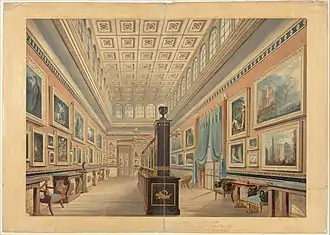Henry Thomas Hope
Henry Thomas Hope (30 April 1808 – 4 December 1862) was a British MP and patron of the arts.

Biography
Henry Thomas Hope was born in London on 30 April 1808, the eldest of the three sons of the connoisseur Thomas Hope (1769–1831) and his wife Louisa de la Poer Beresford. However, he was estranged from his brothers (including Alexander James Beresford Hope) when he inherited their father's art collections, wealth and property along with those of their uncle Henry Philip Hope (died 1839). Part of Hope's inheritance from his uncle included the Hope Diamond.[1]
He entered a political career after studying at Eton College and Trinity College, Cambridge (1825–29).[2] He was briefly a Groom of the Bedchamber to Kings George IV and William IV between March and November 1830.[3]
He also founded the Art Union of London and the Royal Botanic Society, as well as serving as vice-president of the Society of Arts and president of the Surrey Archaeological Society. Displaying his old masters collection to the public at his London house on Duchess Street, a mansion at 116 Piccadilly and at Deepdene House in Surrey. He was also a patron to idealists such as Young England and the Spanish Carlists and helped organise the 1851 Great Exhibition. From 1851 to 1858 he chaired the Eastern Steam Navigation Company for Isambard Kingdom Brunel, with Henry having been the Great Eastern's chief fundraiser.
In 1853, he purchased Blayney Castle in Castleblayney, County Monaghan, Ireland, from The 12th Baron Blayney. He renamed the country house as Hope Castle.
Death
Hope died on 4 December 1862 at 116 Piccadilly, London.
Personal life
In 1851 Hope married Anne Adele Bichat, having already had a daughter named Henrietta Adela with her in 1843. The marriage legitimised Henrietta, who in 1861 married Lord Lincoln (later sixth Duke of Newcastle).[4] After her first husband's death, Henrietta married Thomas Theobald Hohler.[5]
Constituencies
- East Looe, 1829–32
- Gloucester, stood unsuccessfully in December 1832
- Marylebone, stood unsuccessfully in March 1833
- Gloucester, 1833–52
References
- Robert J. Girod (2008). Infamous Murders and Mysteries: Cold Case Files and Who-Done-Its. iUniverse. p. 152.
- "Hope, Henry Thomas (HP825HT)". A Cambridge Alumni Database. University of Cambridge.
- http://courtofficers.ctsdh.luc.edu/Index-H.pdf
- Edward Walford (1869). The County Families of the United Kingdom Or, Royal Manual of the Titled and Untitled Aristocracy of Great Britain and Ireland. United Kingdom: R. Hardwicke. p. 717. Retrieved 13 July 2017.
- J. Robert Maguire (24 January 2013). Ceremonies of Bravery: Oscar Wilde, Carlos Blacker, and the Dreyfus Affair. OUP Oxford. p. 12.
External links
- Hansard 1803–2005: contributions in Parliament by Henry Thomas Hope
- "Hope, Henry Thomas". Oxford Dictionary of National Biography (online ed.). Oxford University Press. doi:10.1093/ref:odnb/42186. (Subscription or UK public library membership required.)
| Parliament of the United Kingdom | ||
|---|---|---|
| Preceded by James Buller-Elphinstone William Lascelles |
Member of Parliament for East Looe 1829–1832 With: William Lascelles to 1830 Thomas Arthur Kemmis from 1830 |
constituency abolished |
| Preceded by Maurice Berkeley John Phillpotts |
Member of Parliament for Gloucester 1833–1841 With: John Phillpotts to 1835 Maurice Berkeley 1835–37 John Phillpotts from 1837 |
Succeeded by John Phillpotts Maurice Berkeley |
| Preceded by John Phillpotts Maurice Berkeley |
Member of Parliament for Gloucester 1847–1852 With: Maurice Berkeley |
Succeeded by Maurice Berkeley William Philip Price |